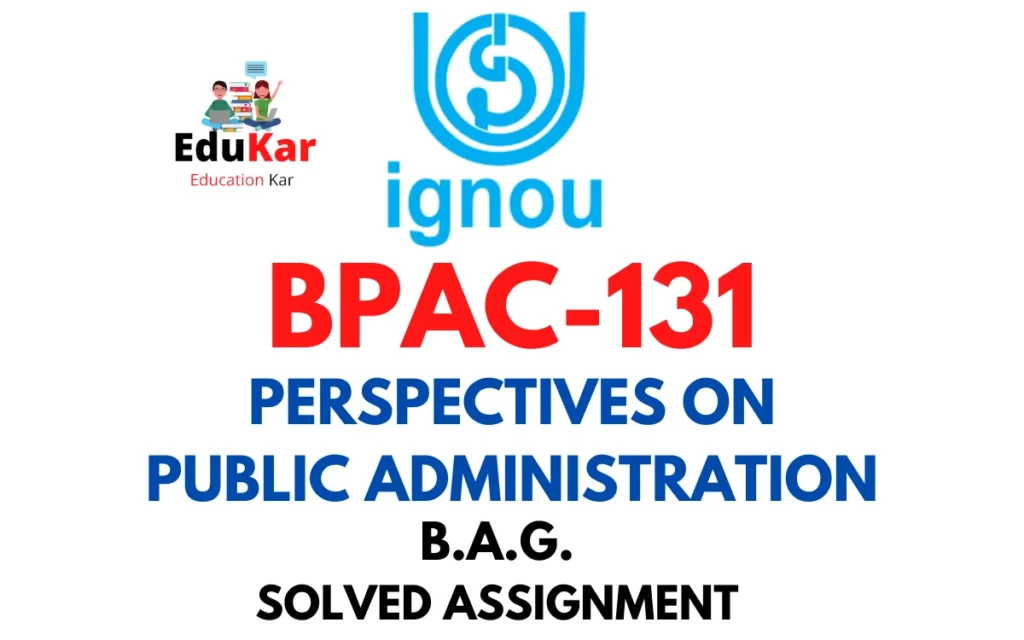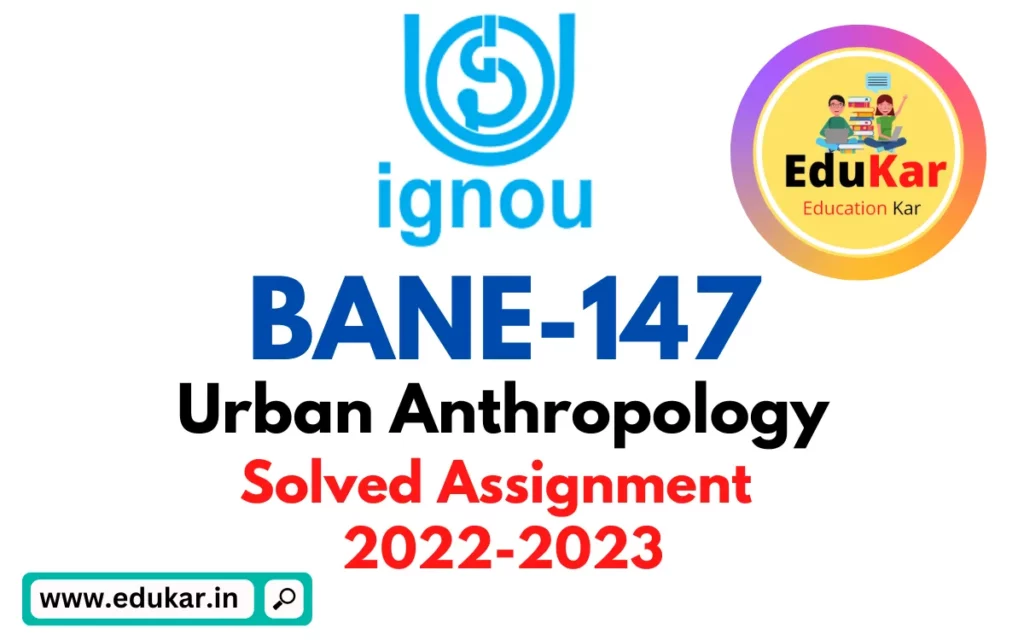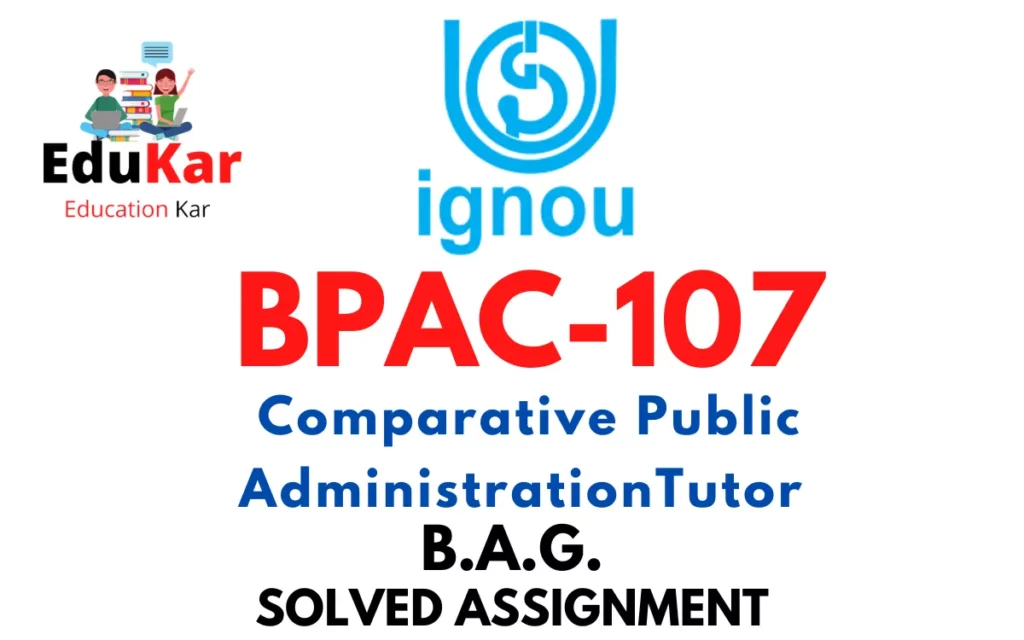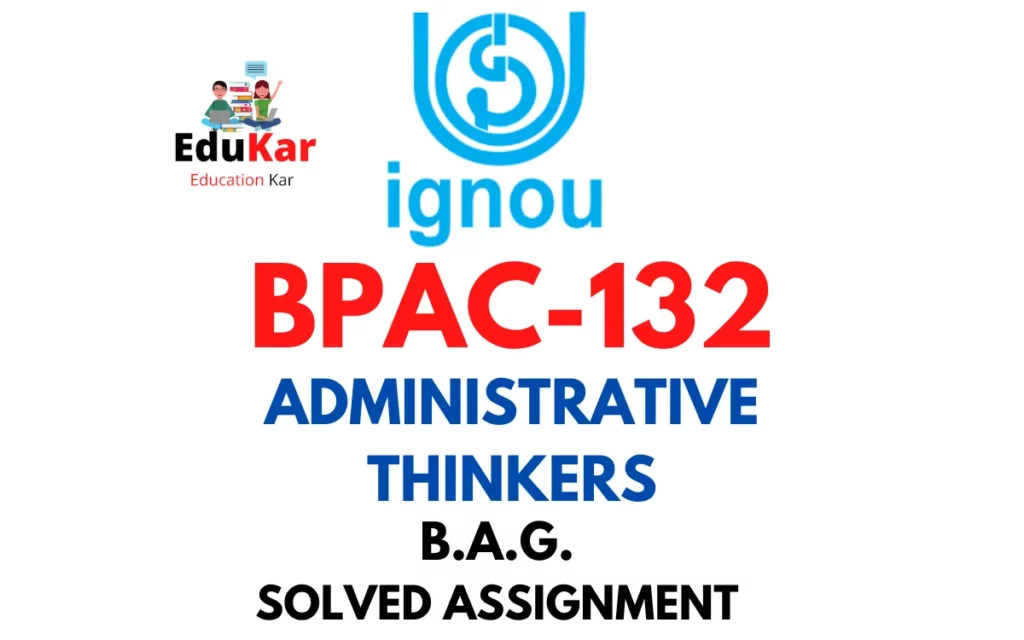Contents
- 1 Assignment A
- 2 Answer the following questions in about 500 words each.
- 3 1. Examine the scope of development administration.
- 4 2. Write a note in brief on administrative reforms undertaken by the government since independence.
- 5 Assignment B
- 6 Answer the following questions in about 250 words each.
- 7 3. Discuss the concept of New Public Service.
- 8 4. Analyse the role of local bodies in development.
- 9 5. Explain the Self-help group approach to development.
- 10 Assignment C
- 11 Answer the following questions in about 100 words each.
- 12 6. Bring out the advantages of political parties.
- 13 7. Explain the functions of NITI Aayog.
- 14 8. Voluntary organisations can play a pioneering role in the country’s development-Elaborate.
- 15 9. Write a note on Janaagraha Centre for Citizenship and Democracy.
- 16 10. What are the roles and responsibilities of Village Health Sanitation Nutrition committees (VHSNCs) ?
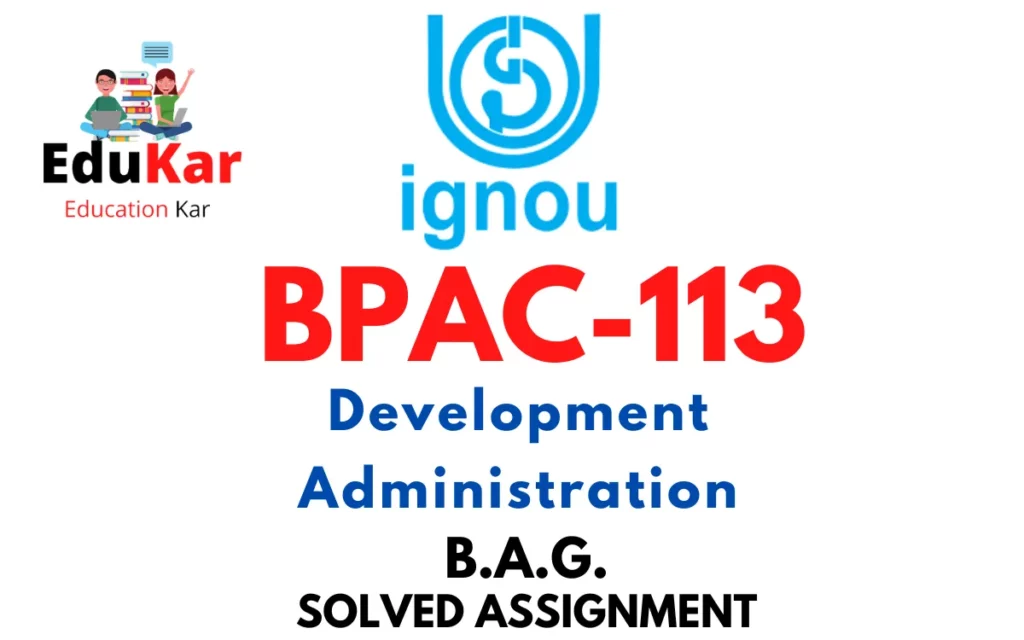
| Title | BPAC-113: IGNOU BAG Solved Assignment 2022-2023 |
| University | IGNOU |
| Degree | Bachelor Degree Programme |
| Course Code | BPAC-113 |
| Course Name | Development Administration |
| Programme Name | Bachelor of Arts (General) |
| Programme Code | BAG |
| Total Marks | 100 |
| Year | 2022-2023 |
| Language | English |
| Assignment Code | ASST/TMA/July 2022-January 2023 |
| Assignment PDF | Click Here |
| Last Date for Submission of Assignment: | For June Examination: 31st April For December Examination: 30th September |

Assignment A
Answer the following questions in about 500 words each.
1. Examine the scope of development administration.
Ans: Development administration is a field of study that emerged in the mid-20th century with the aim of applying management techniques to the process of economic development in developing countries. The scope of development administration is quite broad and encompasses several different areas of focus.
One area of focus for development administration is the implementation of development projects. This involves managing the process of designing, financing, and implementing projects that are intended to promote economic growth and development. Development projects can range from infrastructure development, such as building roads and bridges, to social development initiatives, such as promoting access to education and healthcare.
Another area of focus for development administration is public sector reform. This involves improving the efficiency and effectiveness of government agencies and institutions, which can help to promote economic growth and development. Public sector reform may involve restructuring government agencies, improving government services, or implementing new policies and regulations to promote economic development.
A third area of focus for development administration is the promotion of private sector development. This involves creating an environment that is conducive to private sector investment and entrepreneurship. This can include policies and regulations that promote economic freedom, such as tax incentives and streamlined regulations, as well as programs that provide technical assistance and support to small businesses and entrepreneurs.
A fourth area of focus for development administration is the management of development assistance. This involves overseeing the distribution of foreign aid and other forms of development assistance, and ensuring that these resources are used effectively to promote economic development. Development assistance may include grants, loans, and technical assistance, as well as support for capacity building and institutional development.
2. Write a note in brief on administrative reforms undertaken by the government since independence.
Ans: Since independence, the Indian government has undertaken several administrative reforms to improve the efficiency, effectiveness, and accountability of the public administration system. Some of the key administrative reforms implemented in India are:
- Administrative Reforms Commission (ARC): The government of India established the ARC in 1966 to examine the working of the administrative system and suggest reforms. The ARC submitted several reports on various aspects of governance, which led to significant changes in the administrative system.
- Centralization of administrative power: In the initial years after independence, the government centralized administrative power to establish a strong state. This included the creation of the All India Services, which brought the Indian Administrative Service (IAS), Indian Police Service (IPS), and Indian Forest Service (IFS) under the control of the central government.
- Decentralization of administrative power: In the 1990s, the government adopted a policy of decentralization to empower local governments and increase their accountability. This led to the establishment of the Panchayati Raj system, which devolved administrative power to the village and district levels.
- Right to Information Act: The government enacted the Right to Information Act in 2005 to increase transparency and accountability in the administration. The act allows citizens to access information held by public authorities.
- E-governance: The government has also implemented several e-governance initiatives to improve service delivery and reduce corruption. Some of the key initiatives include the National e-Governance Plan (NeGP), Digital India, and the Aadhaar biometric identification system.
These administrative reforms have had a significant impact on the functioning of the Indian government, and have helped to improve the efficiency, transparency, and accountability of the administrative system.
Assignment B
Answer the following questions in about 250 words each.
3. Discuss the concept of New Public Service.
Ans: The concept of New Public Service (NPS) is an emerging framework for public administration that emphasizes the importance of public service values, democratic governance, and a collaborative approach to problem-solving. The NPS approach was first proposed in the 1990s by scholars such as Janet Denhardt and Robert Denhardt as a response to criticisms of the traditional, bureaucratic model of public administration.
The NPS model emphasizes that public administrators should be accountable to the public they serve, and work collaboratively with citizens, non-profit organizations, and other stakeholders to address complex public problems. This approach emphasizes the importance of values such as public service, social equity, and democratic governance.
The NPS approach also emphasizes the importance of collaboration and partnerships between government agencies and other stakeholders. It emphasizes that public administrators should work with citizens, non-profit organizations, and other stakeholders to co-create public policies and programs that meet the needs of the community.
The NPS approach also emphasizes the importance of leadership, and calls on public administrators to be facilitators and coaches, rather than traditional bureaucratic managers. This requires a focus on building trust, empowering employees, and developing a culture of continuous learning and improvement.
Overall, the NPS model represents a shift away from the traditional bureaucratic model of public administration, and towards a more collaborative, participatory, and value-driven approach. It represents an effort to build a more democratic, equitable, and responsive public sector, that can effectively address the complex challenges facing society today.
4. Analyse the role of local bodies in development.
Ans: Local bodies, such as city councils, town councils, and village councils, play a crucial role in the development of their respective communities. These bodies are responsible for providing basic services and amenities, promoting economic growth, and ensuring social welfare in their communities. In this analysis, we will explore the role of local bodies in development and highlight some of the key challenges they face in carrying out their mandate.
One of the most important roles of local bodies is to provide basic services and amenities to their communities. These include services such as water supply, sanitation, waste management, and street lighting. Local bodies are also responsible for maintaining public infrastructure such as roads, bridges, and public buildings. By providing these basic services, local bodies help improve the quality of life of their citizens and promote economic growth.
In addition to providing basic services, local bodies also play an important role in promoting economic development. They are responsible for creating an environment that is conducive to business growth and investment. This includes developing infrastructure such as industrial parks, promoting tourism, and providing incentives to attract new businesses to their communities. By promoting economic development, local bodies can create jobs, increase the tax base, and generate new sources of revenue for their communities.
Local bodies are also responsible for ensuring social welfare in their communities. This includes providing social services such as healthcare, education, and housing. Local bodies are often the first point of contact for citizens in need of these services, and they are responsible for ensuring that these services are accessible and of good quality.
Despite their important role, local bodies face a number of challenges in carrying out their mandate. One of the biggest challenges is a lack of financial resources. Many local bodies have limited financial resources and are heavily reliant on funding from central governments. This can make it difficult for them to provide basic services and invest in economic development.
Another challenge faced by local bodies is a lack of capacity. Many local bodies lack the technical expertise and resources necessary to carry out their mandate effectively. This can lead to a lack of coordination, poor service delivery, and corruption.
5. Explain the Self-help group approach to development.
Ans: The Self-Help Group (SHG) approach to development is a community-driven approach that aims to empower people, particularly women, to take control of their lives and improve their economic, social, and political status. SHGs are small groups of people who come together voluntarily to save money, provide mutual support, and undertake income-generating activities. The SHG approach is based on the principles of participatory development, which emphasizes the active involvement of communities in the development process.
The SHG approach involves forming groups of 10-20 people, mostly women, who pool their savings and provide loans to each other. The groups meet regularly to discuss their progress, share experiences, and plan their activities. SHGs are typically formed around a common interest or need, such as improving access to credit, developing skills, or starting a business.
One of the main advantages of the SHG approach is that it empowers women by giving them greater control over their lives and increasing their economic independence. Women who participate in SHGs are often able to access credit and start businesses, which can lead to improved household income and a greater say in decision-making. Additionally, the support provided by SHG members can help women overcome social isolation and build confidence.
The SHG approach has been successful in many parts of the world, particularly in rural areas where traditional gender roles may limit women’s participation in economic activities. In India, for example, the SHG approach has been used to improve access to credit and promote women’s entrepreneurship. In Africa, the SHG approach has been used to improve access to health care and education.
Despite its many advantages, the SHG approach also faces several challenges. For example, it can be difficult to form and sustain SHGs in areas where social networks are weak or where there is a lack of trust. Additionally, SHGs may be vulnerable to infiltration by political or other interest groups, which can undermine their effectiveness.
Assignment C
Answer the following questions in about 100 words each.
6. Bring out the advantages of political parties.
Ans: Political parties play a vital role in any democratic system. Some of the advantages of political parties are:
- Representation: Political parties represent different groups and communities in the society. They provide a platform for people to participate in the political process and to have their voices heard.
- Accountability: Political parties hold their elected representatives accountable to the party’s policies and values. This ensures that elected officials remain true to their campaign promises and work towards the betterment of the society.
- Governance: Political parties provide a framework for governance and policy-making. They develop and promote policy ideas, and provide a means for citizens to elect representatives who share their views and will work to implement these policies.
- Stability: Political parties help to ensure political stability by providing a stable and predictable means of transferring power. This is achieved through the regular holding of elections and the peaceful transfer of power from one party to another.
- Participation: Political parties provide opportunities for citizens to participate in the political process. This includes the opportunity to join a political party, campaign for a candidate, and vote in elections. Political parties also provide a means for citizens to raise concerns and have them addressed by their representatives.
7. Explain the functions of NITI Aayog.
Ans: NITI Aayog, or the National Institution for Transforming India, is a policy think tank and advisory body of the Government of India. It was established in 2015 to replace the Planning Commission, and it performs several functions, including:
- Formulating National Development Plans: NITI Aayog is responsible for formulating long-term and medium-term plans for the country’s economic and social development. It coordinates with state governments, local bodies, and other stakeholders to develop these plans.
- Monitoring and Evaluation: NITI Aayog is responsible for monitoring and evaluating the implementation of government programs and policies. It assesses their impact on the economy, society, and the environment, and provides feedback to the government.
- Promoting Cooperative Federalism: NITI Aayog promotes cooperative federalism by encouraging collaboration and partnership between the central government and state governments. It provides a platform for states to share their best practices and learn from each other.
- Providing Technical Support: NITI Aayog provides technical support and expertise to the central and state governments in various areas such as health, education, agriculture, and infrastructure.
- Fostering Innovation: NITI Aayog promotes innovation and entrepreneurship in the country. It develops policies and programs to encourage the growth of startups, and fosters the development of new technologies and innovations.
- International Cooperation: NITI Aayog promotes international cooperation by engaging with other countries and organizations on issues related to sustainable development, technology, and innovation.
8. Voluntary organisations can play a pioneering role in the country’s development-Elaborate.
Ans: Voluntary organizations, also known as non-governmental organizations (NGOs), can play a pioneering role in the country’s development in several ways. Some of the ways in which they can contribute are:
- Grassroots outreach: Voluntary organizations can reach out to the grassroots level and work with communities to identify their needs and develop solutions. They can mobilize resources, create awareness, and encourage community participation to bring about sustainable change.
- Innovative solutions: Voluntary organizations can bring in innovative solutions and fresh perspectives to tackle complex problems. They can experiment with new ideas and approaches, and pilot-test new models before scaling them up.
- Advocacy and lobbying: Voluntary organizations can play a critical role in advocacy and lobbying for policy changes and reforms. They can work with the government and other stakeholders to raise awareness of issues, and advocate for laws and policies that promote social justice and human rights.
- Capacity building: Voluntary organizations can build the capacity of local communities by imparting knowledge, skills, and training. They can promote education, health, and social welfare by providing resources, counseling, and other support services.
- Resource mobilization: Voluntary organizations can mobilize resources from donors, philanthropists, and other sources to support their initiatives. They can channel these resources towards sustainable development projects and programs that benefit the marginalized and vulnerable sections of the society.
9. Write a note on Janaagraha Centre for Citizenship and Democracy.
Ans: Janaagraha Centre for Citizenship and Democracy is a non-profit organization based in Bangalore, India. It was founded in 2001 by a group of socially conscious individuals with the aim of promoting active citizenship and participatory democracy in India. The organization works to improve the quality of life in urban areas and focuses on urban governance, urban planning, and urban reforms.
Janaagraha’s flagship program is the ‘I Paid a Bribe’ initiative, which was launched in 2010 to raise awareness of corruption in India. The initiative allows citizens to report incidents of bribery and corruption anonymously and provides a platform to share their experiences. The data collected is used to analyze corruption trends and develop policy recommendations to combat corruption.
Janaagraha has also developed the ‘City-Systems Framework’ to assess the quality of governance in Indian cities. The framework evaluates the performance of cities in areas such as urban planning, finance, and service delivery. The assessment is based on a set of indicators, and the results are used to identify areas for improvement and develop reform agendas.
Janaagraha also conducts research and advocacy on issues related to urban governance and citizen participation. It provides training and capacity-building programs for urban local bodies, elected representatives, and civil society organizations. Janaagraha has partnered with several organizations and institutions to promote participatory democracy and citizen engagement in urban governance.
10. What are the roles and responsibilities of Village Health Sanitation Nutrition committees (VHSNCs) ?
Ans: Village Health Sanitation Nutrition Committees (VHSNCs) are community-based structures that have been established to improve the health, hygiene, and nutrition of communities, particularly in rural areas. The VHSNCs are typically comprised of local community members, including women and marginalized groups. The roles and responsibilities of VHSNCs include mobilizing the community to identify health and sanitation problems, prioritizing the most critical health issues, and planning and implementing community-based interventions. They also monitor the quality of health and nutrition services in their area and provide feedback to health providers. Additionally, VHSNCs work to promote awareness about health and sanitation issues and advocate for the rights of women and marginalized groups in their communities.
How to Download BPAC-113 Solved Assignment?
You can download it from the www.edukar.in, they have a big database for all the IGNOU solved assignments.
Is the BPAC-113 Solved Assignment Free?
Yes this is absolutely free to download the solved assignment from www.edukar.in
What is the last submission date for BPAC-113 Solved Assignment?
For June Examination: 31st April, For December Examination: 30th October









